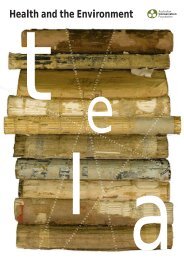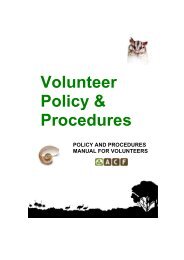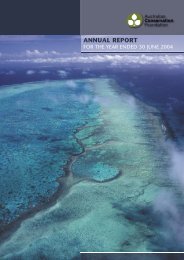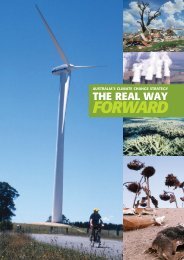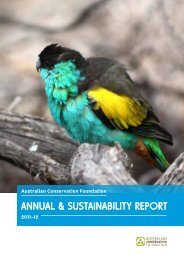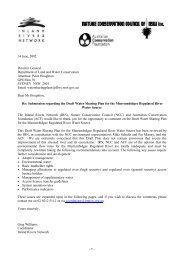Protecting Western Australia's Big Blue Backyard - The Pew ...
Protecting Western Australia's Big Blue Backyard - The Pew ...
Protecting Western Australia's Big Blue Backyard - The Pew ...
- No tags were found...
Create successful ePaper yourself
Turn your PDF publications into a flip-book with our unique Google optimized e-Paper software.
PROTECTING WESTERN AUSTRALIA’SBIG BLUE BACKYARD<strong>The</strong> marine life from Kalbarri to Eucla isastonishing in its breadth and distinctivenessand is unique on a global scale. But it remainsunprotected. <strong>The</strong> delivery of a CAR network oflarge no-take marine reserves offers the best hopefor maintaining viable populations of the region’smarine species.Leading scientists from around the worldhave strongly advocated the creation of suchareas in their writings and public commentary.<strong>The</strong> prestigious American Academy for theAdvancement of Science and the AustralianMarine Sciences Association both support theestablishment of no-take areas. In 2003 theWorld Parks Congress in Durban urged all nationsto establish networks of no-take areas coveringat least 20–30 per cent of each marine habitatby 2012. Most recently some of Australia’s topscientists have added their support to theproposal to create the world’s largest no-take areain the Coral Sea covering an area of one millionsquare kilometres.Monitoring in many no-take areas around theworld has shown fish abundance is higher inno-take reserves than in areas that continue tobe fished. <strong>The</strong> increase in the number and size offish and other marine species within large no-takemarine reserves, and their potential spillover acrossreserve boundaries, could create opportunities forrecruitment outside the reserves.<strong>The</strong> eggs, larvae, juveniles and adults of manyspecies are carried along the region by theLeeuwin Current. This transport from marinereserves and the protection of nursery andspawning areas will give greater fish stock securityfor commercial and recreational fishers alike.Protection will also allow overfished stocks of the‘Vulnerable 5’ (West Australian dhufish, baldchingroper, breaksea cod, pink snapper and redsnapper), orange roughy and sharks to rebuild.It will also support the recovery of blue whales,leatherback turtles and other threatened species,and enhance the food supply of Australian sealions and New Zealand fur seals.<strong>The</strong> dispersal of larvae, which is critical to thefuture of the western rock lobster, as well asnutrient cycling and pollutant breakdown, couldbe encouraged by large no-take marine reserves.<strong>The</strong> reserves will also provide opportunitiesfor research into the carbon storage potentialof protected sea floor communities, seagrassmeadows and undisturbed sediments that couldsupport the global fight against climate change.Large no-take marine reserves protecting uniquelocal marine life and features can strengthen theregional tourism brand and help protect localeconomies from contractions of tourism marketsduring financial crises.<strong>The</strong>y can also broaden the economic profile ofa region and reduce the dependence of traditionalmarine-based industries such as fisheries now indecline due to rising costs and overexploitationof fish stocks. And the government declarationprocess for no-take marine reserves can alsohelp put those fisheries on a more viable footingthrough the strategic application of structuraladjustment schemes.<strong>The</strong> growing whale watching, diving andecotourism sectors in the region will be givena huge boost and will in turn support coastaleconomies adjusting to changes in fisheriesmanagement.Large no-take marine reserves can also becomelong-term monitoring sites for scientists. <strong>The</strong>se willenable scientists to better understand the marineenvironment, examine the effects of fishing andimprove the way we use and manage it. By publiclycommunicating that improved understanding, thecommunity will become increasingly awareof marine conservation needs.In order to secure what is unique, importantand threatened in <strong>Western</strong> Australia’s bigblue backyard the Save our Marine LifeCollaboration of the Conservation Councilof <strong>Western</strong> Australia, the Australian ConservationFoundation, <strong>The</strong> Wilderness Society,WWF-Australia, the Australian MarineConservation Society, <strong>The</strong> Nature Conservancyand the <strong>Pew</strong> Environment Group has been formed.It is working with scientists, the Australian and<strong>Western</strong> Australian governments and those whowork and play in the marine environment to ensurethese significant benefits are realised throughestablishing a CAR network of large no-takemarine reserves from Kalbarri to Eucla.Such protection should be extended to habitatsthat are critical to the survival of marine speciesand their key feeding, breeding, nursery andresting areas. <strong>The</strong> ecological links betweenoffshore and inshore, between sea floor and seasurface, and between the abyssal plain, slopeand shelf should be maintained. It is insufficientto protect a species without protecting the watercolumn and sea floor it relies upon.<strong>The</strong> world has vested responsibility for the region’smarine life and its habitats with the Australianpeople. Unlike many other areas of the globe,Australia still has the opportunity and the capacityto act in advance of the rising tide of humanpressure on our oceans. But time is short as marinepollution, habitat damage and exploitation areincreasingly taking their toll.A 2008 global survey by the World ResourcesInstitute identified 415 dead zones in the world’soceans, a tripling of the number found in the1990s. Dead zones are places that are starved ofoxygen because land-based sources of pollutionhave encouraged blooms of algae. <strong>The</strong> algaeeventually die and are broken down by bacteriathat consume oxygen.Four of the dead zones identified by thesurvey are located off Sydney, Hobart,in the Gippsland Lakes and south of Perth.Six of 15 ‘areas of concern’ identified for Australiawere along the west coast of the Kalbarri to Euclaregion, while another was on the south coast.<strong>The</strong> survey’s findings clearly demonstrate thecritical links between the health of catchments,coasts and marine waters, and the need forintegrated protection and management.<strong>The</strong> establishment of a CAR network of largeno-take marine reserves from Kalbarri to Eucla willlay the foundation necessary to maintain the healthof the region’s precious marine life, and preservethe culture, heritage, traditions, economies andlifestyle of <strong>Western</strong> Australians and their bigblue backyard.62<strong>The</strong> region is a turning point formigrating southern bluefin tuna.<strong>The</strong>y choose to either go east to thePacific Ocean or west towards Africa© Valerie and Ron Taylor / www.ardea.com



